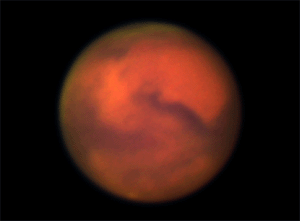 Mars as seen through Chabot Space & Science Center’s 20-inch telescope near the 2003 close encounter. Credit: Conrad Jung/Chabot Space & Science CenterIf you take away no other message from this blog, just remember this: the planet Mars is NOT passing close to Earth this August and will NOT appear as large as the Full Moon. There; disclaimer delivered.
Mars as seen through Chabot Space & Science Center’s 20-inch telescope near the 2003 close encounter. Credit: Conrad Jung/Chabot Space & Science CenterIf you take away no other message from this blog, just remember this: the planet Mars is NOT passing close to Earth this August and will NOT appear as large as the Full Moon. There; disclaimer delivered.
As August approaches, the ghost of Mars returns to haunt us, in the form of emails and phone calls from people asking if it's true that Mars is about to get closer to Earth than it has been in a gazillion years—so close that it will look as big as the Full Moon.
I say "ghost" because it simply isn't true, here in 2009. I say "haunt" because, six years ago, it was true—at least, partly.
The time: August 27, 2003. The scene: Earth and Mars. The event: Mars is coming into opposition—the time when Earth passes directly between Mars and the Sun, and consequently Mars is closest to us and at the opposite point in the sky from the Sun—hence "opposition." A routine encounter, one that happens about every 2.2 years. But what's different with this Mars opposition is the distance between Earth and Mars at closest approach: the two planets are closer together than they have been in a very long time: a bit less than 35 million miles.
This was a very big deal, you may recall. We remember it very well at Chabot: On one of the evenings that weekend, we had 2000 people who came up to see Mars through our telescopes…. A close opposition is the best time to see a planet, and this was closer than average for Mars by maybe 10 million miles. (It was at another very close opposition of Mars when Percival Lowell made his famous "Martian canals" observations and Martian civilization hypothesis, back in 1894.)
